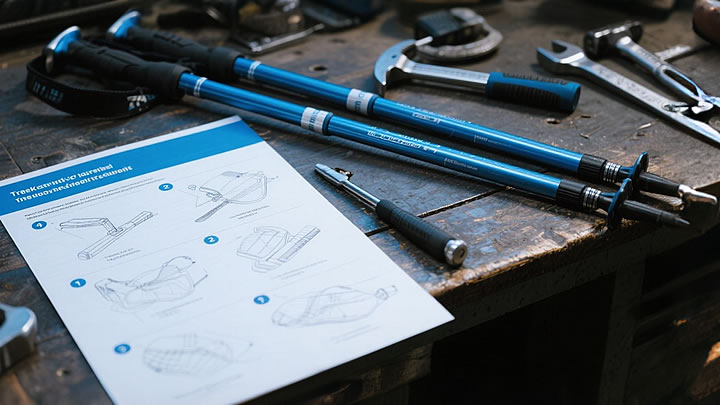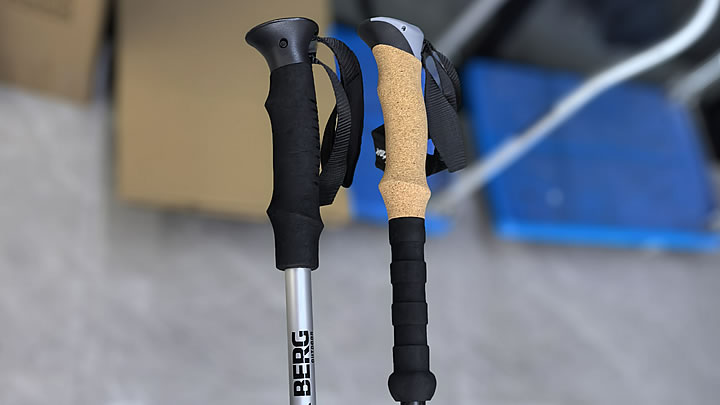Cork vs Foam Trekking Pole Grips: The Ultimate Comfort & Performance Showdown
Choosing the right trekking pole grip isn't just about comfort – it significantly impacts control, longevity, and performance in varying conditions. The cork vs. foam debate is central for hikers investing in reliable gear. Let's dissect the strengths, weaknesses, and best-use scenarios for each material to help you make the perfect choice.

The Contenders: Material Matters
- Natural Cork: Harvested from cork oak bark (a sustainable process), processed, and bonded to the pole shaft. Known for its unique cellular structure.
- Foam (EVA): A synthetic polymer (Ethylene-Vinyl Acetate), molded into shape around the shaft. Varies significantly in density and quality.
Round 1: Comfort & Feel
- Cork: The Custom ContourMolds to Your Hand: Cork's slightly pliable nature allows it to gradually conform to the shape of your hand over time, creating a personalized, glove-like fit.Temperature Neutral: Excellent insulator. Feels noticeably less cold in freezing conditions and less hot in scorching sun compared to synthetics.Firm, Secure Feel: Offers a solid connection to the pole, translating energy efficiently without excessive cushioning.
- Foam: The Instant CushionInitial Softness: Typically provides a softer, more cushioned feel right out of the gate, which some find immediately comfortable, especially on short hikes.Consistent Texture: Maintains its molded shape; doesn't mold to the user.Varies by Density: High-density foam offers more support and durability but less initial softness. Low-density foam feels squishier but compresses and degrades faster.
Round 2: Performance in Wet & Sweaty Conditions
- Cork: The Moisture MasterNaturally Wicking: Cork's micro-cellular structure draws moisture (sweat or light rain) away from your skin and allows it to evaporate. Your hand stays drier.Grip When Wet: This wicking action, combined with cork's natural texture, provides a remarkably secure and non-slippery grip even when saturated. Performance improves slightly when damp.Odor & Mold Resistant: Naturally antimicrobial and resistant to developing unpleasant smells or mildew growth.
- Foam: The SpongeAbsorbs Moisture: EVA foam acts like a sponge, readily absorbing sweat and water. This makes grips heavier, colder, and significantly more slippery when wet.Slippery Hazard: Wet foam grips drastically reduce control and security, especially critical on steep or technical terrain.Odor Retention: Trapped moisture and bacteria can lead to persistent unpleasant odors over time.
Round 3: Durability & Longevity
- Cork: The Long-Haul PerformerResilient Structure: High-quality cork compresses slightly but rebounds well and maintains its structural integrity for years, even with heavy use.Wears Gracefully: While it may develop a patina or slight smoothing, it rarely cracks, flakes, or becomes unusable. Texture remains functional.UV Resistance: Highly resistant to degradation from sunlight.
- Foam: The Short-Term SolutionCompression & Flattening: Constant pressure causes foam to permanently compress and lose its cushioning, especially lower-density versions.Abrasion & Tearing: Foam is more susceptible to nicks, tears from sharp objects (like crampons), and general abrasion wear.UV Degradation: Prolonged sun exposure can cause foam to harden, crack, and become brittle over time.
Round 4: Weight & Cost
- Cork: Generally adds a slight weight penalty compared to the lightest foams, though high-quality cork is still very light. Typically found on mid-range to premium poles, reflecting its performance and longevity benefits.
- Foam: Can be extremely lightweight, especially low-density EVA. The main advantage is cost; foam is the standard grip material on budget-friendly trekking poles.
The Verdict: Which Grip is Right For You?
- Choose CORK Grips If You:Hike frequently in wet, humid, or variable weather.Prioritize long-term durability and value (buy once, cry once).Take multi-day backpacking trips where grip security is paramount.Hike in extreme temperatures (hot or cold).Value a grip that molds to your hand over time.Are investing in higher-performance poles.
- Choose FOAM Grips If You:Need an ultra-budget-friendly pole for occasional, fair-weather day hiking.Prioritize absolute minimum weight (in high-density forms) for racing or ultralight setups where grip performance is secondary to weight savings.Want maximal initial cushioning for short hikes on easy terrain.Don't mind replacing poles more frequently.
Beyond Material: Don't Forget Grip Shape!
Whether cork or foam, the shape of the grip is crucial:
- Anatomical/Contoured: Fits the natural curve of your hand, reducing hot spots. Best for most users.
- Straight: Simpler design, easier to manufacture. Can cause pressure points on long descents.
- Extended Grips ("Lower Grip"): A section of grip material extending down the shaft. Essential for steep terrain where you choke down on the pole. Often made of thinner foam or rubber even on cork-gripped poles.
The Bottom Line:
While foam grips have a place on budget poles or for specific ultralight applications, cork grips deliver superior all-around performance, comfort, and longevity for serious hikers and backpackers. Their ability to manage moisture, maintain grip security in adverse conditions, and withstand years of use makes them the clear winner for anyone investing in trekking poles as essential performance tools, especially in challenging environments. When you're miles from the trailhead with tired hands on a rainy descent, the secure, dry feel of a cork grip is worth its weight in gold. Choose wisely – your hands (and your poles) will thank you.






